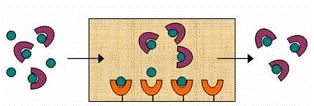Department of Chemistry
Document Type
Article
Date of this Version
4-2009
Citation
Published in final edited form as: J Sep Sci.2009 April ; 32(8): 1145–1155. doi:10.1002/jssc.200800567. Version presented here is from NIH PubMed Central.
Abstract
There has been growing interest in the use of rapid and selective separation methods such as high-performance affinity chromatography (HPAC) or affinity capillary electrophoresis (ACE) for the characterization of drug-protein interactions. L-Tryptophan is commonly used in these and other methods as a site-selective probe for examining the binding of small solutes and drugs at Sudlow site II on the protein human serum albumin (HSA). However, solutions of L-tryptophan can be unstable and are generally prepared fresh daily for these studies. In this report, HPAC was used to examine other indole compounds as possible replacements for L-tryptophan as a site-selective probe for use in the high-throughput screening of drug binding to HSA; the implications of these results in the use of such compounds in ACE were also considered. The probe candidates that were tested included indole-3-acetic acid, indole-3-carboxylic acid, indole-3-butyric acid, indole-3-propionic acid, indole-3-methanol, 3-acetylindole, and 3-methylindole. All of these compounds were found by 1H NMR spectroscopy and UV/vis spectroscopy to be stable for up to three weeks at room temperature when in pH 7.4, 0.067 M phosphate buffer. The binding of these compounds was examined by using columns that contained immobilized HSA. 3-Acetylindole was found to be the best candidate in this group for use as an alternative probe to L-tryptophan for Sudlow site II. This probe had the same binding site and a similar affinity to L-tryptophan but was more stable in aqueous solution, making it suitable for high-throughput screening of drug-HSA binding in both HPAC and ACE.



Comments
Copyright John Wiley & Sons. Used by permission.